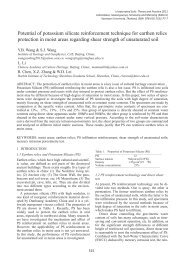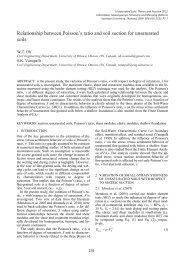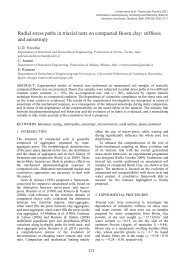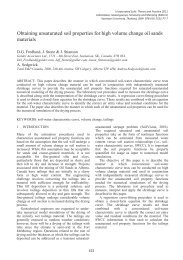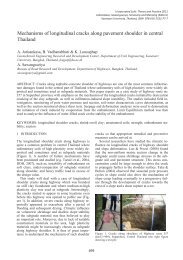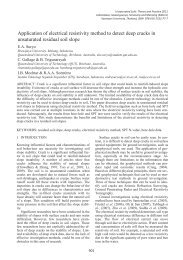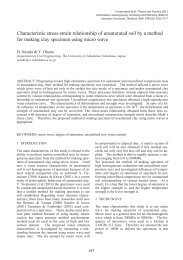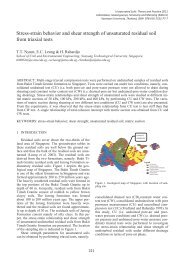Effectiveness of horizontal drains in improving slope stability: a case ...
Effectiveness of horizontal drains in improving slope stability: a case ...
Effectiveness of horizontal drains in improving slope stability: a case ...
You also want an ePaper? Increase the reach of your titles
YUMPU automatically turns print PDFs into web optimized ePapers that Google loves.
Soon after <strong>in</strong>stallation <strong>in</strong> 2007, all 40 <strong>horizontal</strong><strong>dra<strong>in</strong>s</strong>, except for 2, were able to discharge water.The total discharge rate measured from all <strong>dra<strong>in</strong>s</strong>, atthat time, was 652.19 ml/s. However, 71% <strong>of</strong> theyield comes from 5 <strong>dra<strong>in</strong>s</strong> (listed <strong>in</strong> the Table 1)close to the northern side <strong>of</strong> the failure area. Flowrates measured from the other 35 <strong>dra<strong>in</strong>s</strong> range from0-18.02 ml/s, with 31 <strong>of</strong> the <strong>dra<strong>in</strong>s</strong> yield<strong>in</strong>g less than10 ml/s.These observations concurs with Fernandez-Rubio and S<strong>in</strong>gh (1983) which discovered yield <strong>of</strong><strong>horizontal</strong> <strong>dra<strong>in</strong>s</strong> from dry to very high flow rates,with the maximum discharge located <strong>in</strong> the areas <strong>of</strong>fault zones or <strong>slope</strong> failures.The flow rates measured after 3 years were muchless than immediately after <strong>in</strong>stallation. Only theflow rates from 4 <strong>horizontal</strong> <strong>dra<strong>in</strong>s</strong> were able to bemeasured. The total yield was only 114.56 ml/s,17.5% <strong>of</strong> the yield immediately after <strong>in</strong>stallation.Although the flow rates from <strong>horizontal</strong> <strong>dra<strong>in</strong>s</strong>has much reduced after 3 years, the peizometric waterlevel measured on 8 th March 2011 at BH5/SP2, 4years after the <strong>dra<strong>in</strong>s</strong> were <strong>in</strong>stalled, was 5.25 m,about the same level it used to be, immediately afterthe <strong>in</strong>stallation <strong>of</strong> the <strong>dra<strong>in</strong>s</strong>, <strong>in</strong> April 2007.Five <strong>in</strong>cl<strong>in</strong>ometers were <strong>in</strong>stalled to monitor lateralmovement <strong>of</strong> the <strong>slope</strong>. Except for BH2/IC2which is located at mid height next to the landslide,there is very little movement <strong>of</strong> the rest <strong>of</strong> the <strong>slope</strong>s<strong>in</strong>ce the <strong>in</strong>cl<strong>in</strong>ometers were <strong>in</strong>stalled soon after collapse.Figure 6 plots the maximum movement detectedat 2.5m below the ground surface at this <strong>in</strong>cl<strong>in</strong>ometer.It can be seen that there’s about 8mmmovement dur<strong>in</strong>g the <strong>horizontal</strong> <strong>dra<strong>in</strong>s</strong> <strong>in</strong>stallationworks, after which the <strong>in</strong>cl<strong>in</strong>ometer cease to showany.The above observations suggested that <strong>horizontal</strong><strong>dra<strong>in</strong>s</strong> is an effective method to lower down groundwater table and improv<strong>in</strong>g <strong>slope</strong> <strong>stability</strong> <strong>in</strong> the shortand medium term. Further studies are, however, requiredto determ<strong>in</strong>e its effectiveness <strong>in</strong> the longterm.3.2 Results from geophysical surveysThe topography model for the seismic l<strong>in</strong>e S1 issimplified <strong>in</strong> Figure 7. Three seismic boundarieswere detected. The first topmost layer is characterizedby the lowest p-wave velocity with values rang<strong>in</strong>gfrom 260 m/s to a maximum value <strong>of</strong> about 500m/s. These values represent the range <strong>of</strong> seismic velocities<strong>of</strong> the <strong>in</strong>homogeneous near surface soil materials.The second layer is particularly exhibit<strong>in</strong>g lowervelocities <strong>of</strong> 650 to 1300 m/s. On the basis <strong>of</strong> theirreflection configurations, this layer could beassociated with highly weathered rock materials orstiff/hard sediment.The third layer is <strong>in</strong>terpreted as the less weatheredrock mass. The computed seismic velocities rangefrom 1926 to 4350 m/s. Theoretically, the low value<strong>of</strong> seismic velocity is associated with highlyweathered bedrock, whereas the higher valuerepresents relatively less weathered bedrock. Hence,the third seismic unit could be <strong>in</strong>terpreted as highlyand less weathered fresh Schist.Figure 7. Seismic survey result for l<strong>in</strong>e S1Figure 8 shows the 200 m resistivity measurementswith 5 m electrode spac<strong>in</strong>g <strong>of</strong> survey l<strong>in</strong>e R1 (Fig.5). The top layer <strong>of</strong> the pseudo section is <strong>in</strong>terpretedas a dry layer <strong>of</strong> silt and clay with low resistivity <strong>in</strong>the range <strong>of</strong> 10 to 1,000 Ωm. The relatively high resistivity<strong>in</strong> the range <strong>of</strong> 5,000-30,000 Ωm observed<strong>in</strong> second layer comprises <strong>of</strong> slightly weathered t<strong>of</strong>resh schist. Rock Quality Designation (RQD) <strong>of</strong>70%-90% at a depth <strong>of</strong> 11.5m from BH1 substantiatesthis.Figure 8. Resistivity survey result for l<strong>in</strong>e R1757



